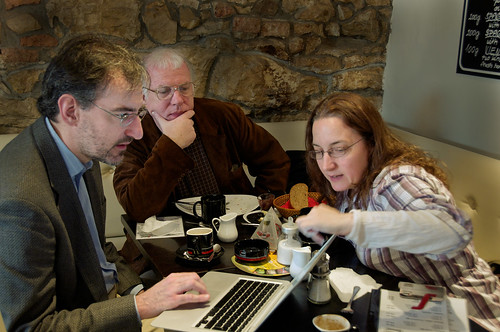I am in Prague for the XML Prague conference, and for a week of meetings of ISO/IEC JTC 1 SC 34. Here is a running report of day 1 of the conference ...
Day 1 kicked off, after a welcome from Mohamed Zergaoui, with a presentation from Mike Kay (zOMG - no beard!) on the state of XML Schema 1.1. Mike gave a lucid tour of XML Schema's acknowledged faults, but maintained these must not distract us too much from the technology's industrial usefulness. XML Schema 1.1 looks to me mostly like a modest revamp: some tidying and clarification under the hood. One notable new feature is however to be introduced: assertions - a cut down version of the construct made popular by Schematron. Mike drew something of collective intake of breath when he claimed it was to XML Schema 1.1's advantage that it was incorprating multiple kinds of validation, and that it was "ludicrous" to validate using multiple schema technologies.
A counterpoint to this view came in the next presentation from MURATA Makoto. Murata-san demonstrated the use of NVDL to validate Atom feed which contain extension, claiming NVDL was the only technology that allows this to be done without manually re-editing the core schemas every time a new extension is used.
After coffee, Ken Holman presented on "code lists" - a sort of cinderalla topic within XML validation but an important one, as code lists play a vital role in document validity in most real world XML documents of any substance. Ken outlined a thorough mechanism for validation of documents using code lists based on Genericode and Schematron.
Before Lunch, Tony Graham took a look at "Testing XSLT" and gave an interesting tour of some of the key technologies in this space. One of his key conclusions, and one which certainly struck a chord with me, was the assertion that ultimately the services of our own eyes are necessary for a complete test to have taken place
Continuing the theme, Jeni Tennison introduced a new XSLT testing framework of her invention: XSpec. I sort of hope I will never have to write substantial XSLTs which merit testing, but if I do then Jeni's framework certainly looks like TDB for TDD!
Next, Priscilla Walmsley took the podium to talk about FunctX a useful-looking general-purpose library of XPath 2.0 (and therefore XQuery) function. Priscilla's talk nicely helped to confirm a theme that has been emerging today, of getting real stuff done. This is not to say there is not a certain geeky intellectualism in the air - but: it's to a purpose.
After tea, Robin Berjon gave an amusing tour of certain XML antipatterns. Maybe because his views largely coincided with mine I thought it a presentation of great taste and insight. Largely, but not entirely :-)
Next up, Ari Nordström gave a presentation on "Practical Reuse in XML". His talk was notable for promoting XLink, which had been a target of Robin Berjon's scorn in the previous session (though now without some contrary views from the floor). Also URNs were proposed as an underpinning for identification purposes - a proposal which drew some protests from the ambient digiverse
To round off the day's proceedings, George Cristian Bina gave a demo of some upcoming features in the next version of the excellent oXygen XML Editor. This is software I am very familiar with, as I use it almost daily for my XML work. George's demo concentrated on the recent authoring mode for oXygen, which allows creation of markup in a more user-friendly wordprocessor-like environment. I've sort of used this on occasion, and sort of felt I've enjoyed it at the time. But somehow I always find myself gravitating back to good old pointy-bracket mode. Maybe I am just an unreconstructed markup geek ...
 Breakfast Geek-out
Breakfast Geek-out